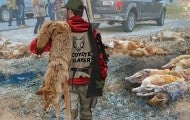Showing 8 of 8 results
It seemed like a good idea at the time: Buy a house with a two-acre property, let our energetic herding dog have the run of the place and spend blissful summer days digging side by side in the dirt with her. And it was blissful, watching Mattie carve out her napping spots behind the ferns and tall...
The term “roadkill” was coined in the 1940s, according to Merriam-Webster, entering the lexicon alongside “DDT” and other harbingers of a dystopian technological age that runs roughshod over the natural world. In the 1990s, the word became a cheeky insult when a rival called then-House Speaker Newt...







